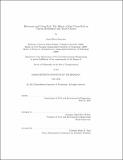Hysteresis and urban rail : the effects of past urban rail on current residential and travel choices
Author(s)
Block-Schachter, David
DownloadFull printable version (11.31Mb)
Alternative title
Effects of past urban rail on current residential and travel choices
Other Contributors
Massachusetts Institute of Technology. Dept. of Civil and Environmental Engineering.
Advisor
Nigel H.M. Wilson.
Terms of use
Metadata
Show full item recordAbstract
Cities are endowed with and accumulate assets based on their unique histories, which in turn define the choice set of the present. These assets range from the natural-sheltered ports, fertile land--to the constructed--concrete and cement, institutions and people. This dissertation examines the effects of one of these assets, urban rail, on residential location and travel behavior, from the era of horsecars and streetcars to the present in Boston. It explores the hysteretical effects of past access to rail--the extent to which the urban system retains the impacts of rail even when it no longer exists. Current density and travel behavior are measurably influenced by past access to rail. The built environment and demographic patterns are found to be the strongest mechanism for these persistent effects. Past access to rail has shaped the city, and that shape has, in turn, affected travel behavior. For density and auto ownership there is an additional measurable effect of past access unexplained by the built environment or demographic patterns. This legacy is plausibly explained by cultural effects--mnemonics--due to personal history, behavioral norms, and zoning/politics. Past access to rail has a stronger effect on density than on auto ownership. The daily choice of modes is almost entirely conditioned on current circumstances. Because places shaped by rail retain its imprint, these findings imply that there is need to consider how policy decisions will influence the city's future choice set. The greatest benefits from the endowments of urban rail are likely where redevelopment costs are low and growth potential is high--particularly light industrial areas near strong central cities. Realizing these changes requires mechanisms that allow and encourage government and private entities to be patient with the long time frames for adaptation to rail infrastructure. One such step is requiring, rather than allowing, supportive zoning and other policies within the Federal Transit Administration's New Starts capital program--including such items as increased as-of-right density, reasonable limits on parking, car sharing, and graduated drivers licensing laws. This research strengthens prior findings that similar approaches can encourage sustainable cultural norms.
Description
Thesis (Ph. D. in Transportation)--Massachusetts Institute of Technology, Dept. of Civil and Environmental Engineering, 2012. This electronic version was submitted by the student author. The certified thesis is available in the Institute Archives and Special Collections. Cataloged from student-submitted PDF version of thesis. Includes bibliographical references (p. 265-284).
Date issued
2012Department
Massachusetts Institute of Technology. Department of Civil and Environmental EngineeringPublisher
Massachusetts Institute of Technology
Keywords
Civil and Environmental Engineering.